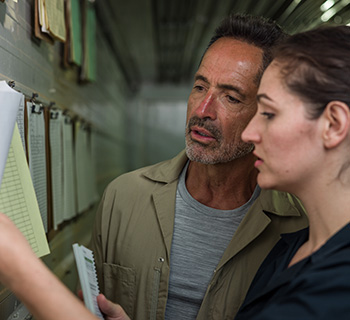Can your barns handle winter weather?
Cold weather can be brutal for the animals under your care, so the more prepared you are, the better. The first step to minimizing disease threats during the year – and especially during winter months – is biosecurity, says Joe George, a production support specialist for Cargill.
“We’ll typically see disease challenges as we come into the winter months and we want to make sure we’re following good biosecurity procedures.”
He recommends producers perform a review with their team, along with their veterinarian, to make sure everyone understands the importance of biosecurity and is up to speed on the farm’s current standard operating procedures related to biosecurity.
“It’s a 24/7 job – we can never let up on our biosecurity for herd health,” he says.
Button-up the Barn

Starting on the outside of the barn, cover tunnel fans so they’re not drafting air on pigs,” says Erin Ehinger, also a production support specialist at Cargill. “If your barn is curtain-sided, use plastic, bubble-wrap or insulation to help minimize draft and decrease fuel use.”
“We just went through a manure-hauling season so pit covers, curtain overlaps and curtain pockets are areas that will let air enter the barn and compromise the environment,” George notes. “Those openings will have a significant impact on the negative pressure within the barn.”
In addition, check soffit openings to make sure they’re free of dust and other material. If you have soffits on both sides of the room, consider closing or modifying the side with predominant winds so excess cold air isn’t entering the attic, the specialists suggest.
“As we think about air coming in, we also need to think about air going out,” says Ehinger. “Check minimum fans by making sure the blades and shutters are clean. Air efficiency can be reduced by up to 30% when fans are dusty and dirty. Those minimum fans need to be working properly, so take time to go outside and get them cleaned off.”
“Depending on the design of the building and ventilation, most of the time we want to move air more slowly,” adds George. “We’ll often widen our bandwidths on minimum stage 1 and stage 2, then stage accordingly as we move forward.”
Other recommendations include:
- Check heaters to make sure they’re in good working order.
- Check that heater settings and alarms are set to cold weather.
- Check ventilation settings and airspeed (invest in an air-speed meter).
- Pressure-check propane lines and tanks.
- Pre-warm the rooms.
- Think safety first when pumping manure.
For more information
Challenge yourself and your employees to spend the extra time and money to help get pigs off to a good start in the winter by following these best-management practices.
“Cargill offers a fall checklist that is available to producers,” says Ehinger. “We also have a pig pocket guide that is a good reference for recommended temperatures and humidity, water flow, heater space and more. It can be a reminder for people as they’re getting their barns ready for winter.”
For more details on winterizing your barns, listen to the full presentation here.
